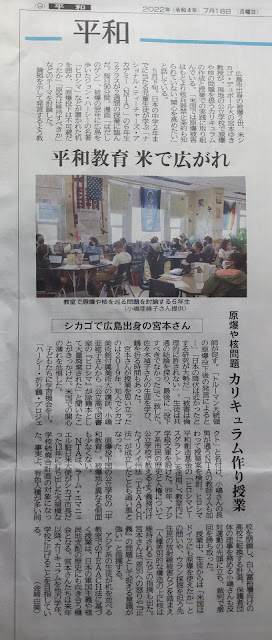平和教育米で広がれ シカゴで広島出身の宮本さん 原爆や核問題カリキュラム作り授業 (Spread peace education in the U.S. Ms. Miyamoto, a native of Hiroshima, created a curriculum to teach about the atomic bomb and nuclear issues in Chicago.)
平和教育 米で広がれ シカゴで広島出身の宮本さん 原爆や核問題 カリキュラム作り授業
広島市出身の被爆2世、米シカゴ・デュポール大の宮本ゆき教授が、現地の公立学校で原爆や核の問題を扱うカリキュラムの作成と授業での実践に取り組んでいる。「米国では原爆被害はもとより核兵器禁止条約も知られていない。関心を高めたい」と話している。
5月下旬、日本の中学2年までに当たる児童生徒が学ぶ「ナショナル・ティーチャーズ・アカデミー(NTA)」の6年生2クラスが2週間の授業に臨んだ。毎日90分間。漫画「はだしのゲン」、被爆の翌年に広島を歩いたジョン・ハーシーの名著「ヒロシマ」などが置かれた机を囲み、「原爆投下は不可避だったか」「原発は維持すべきか」などのテーマを討論した。
論拠を示して発言するよう教師が促す。「トルーマン大統領の原爆投下後の発言によると…」「日本の降伏は近かったとする研究が大勢だ」「被害は倫理的に許されない」。生徒は共通の結論を探り、最後に「投下すべきでなかった」で一致した。佐々木禎子さんの生涯を学び、鶴を折る時間もあった。
宮本さんが授業を思い立ったのは2019年。知人でシカゴ美術館付属美術大の講師、小嶋亜維子さんから「公立高で図書室の『ヒロシマ』が除籍本として大量廃棄された」と聞いたことがきっかけだ。米国での関心の薄れを危惧した。
子どもたちに学習機会を―。「ハーシー・折り鶴・プロジェクト」と名付け、小嶋さんの長男が通うNTAの教師2人も加わって授業案を検討。ヒロシマ平和創造基金の「ヒロシマピースグラント」を活用し、教室内に学級文庫を設けた。昨年、アジア系市民の歴史と人権について公立学校で教えるよう義務付けたイリノイ州法「TEAACH(ティーチ)法」が成立したことも追い風となった。
原爆投下国の公立学校の「平和教育」。被爆地と異なる側面も少なくない。
NTAは、ラーム・エマニュエル駐日米大使がシカゴ市長だった13年に打ち出した大規模な学校統廃合計画の対象になった。事実上、有色人種が多い同校を閉鎖し、白人富裕層向けの高校に転換する計画。保護者団体の理事を務める小嶋さんも反対運動の先頭に立ち、裁判で撤回を勝ち取った。
授業中、生徒からは「米国はドイツにも原爆を使えたか」との問いや、ウラン採掘を担う先住民の放射線被害などを踏まえ「人種差別的な構造の上に核は維持される」などの指摘も出た。宮本さんは「差別への怒りや『正義』の問題として捉える意識が強い」と指摘する。
アジア系の生徒が机を並べる教室でのTEAACH法に基づく授業は、日本の軍国主義や植民地支配の歴史にも向き合う機会となる。宮本さんたちは来年以降、カリキュラムを他の学年、学校に広げることを目指している。(金崎由美)
(2022年7月18日朝刊掲載)
5月下旬、日本の中学2年までに当たる児童生徒が学ぶ「ナショナル・ティーチャーズ・アカデミー(NTA)」の6年生2クラスが2週間の授業に臨んだ。毎日90分間。漫画「はだしのゲン」、被爆の翌年に広島を歩いたジョン・ハーシーの名著「ヒロシマ」などが置かれた机を囲み、「原爆投下は不可避だったか」「原発は維持すべきか」などのテーマを討論した。
論拠を示して発言するよう教師が促す。「トルーマン大統領の原爆投下後の発言によると…」「日本の降伏は近かったとする研究が大勢だ」「被害は倫理的に許されない」。生徒は共通の結論を探り、最後に「投下すべきでなかった」で一致した。佐々木禎子さんの生涯を学び、鶴を折る時間もあった。
宮本さんが授業を思い立ったのは2019年。知人でシカゴ美術館付属美術大の講師、小嶋亜維子さんから「公立高で図書室の『ヒロシマ』が除籍本として大量廃棄された」と聞いたことがきっかけだ。米国での関心の薄れを危惧した。
子どもたちに学習機会を―。「ハーシー・折り鶴・プロジェクト」と名付け、小嶋さんの長男が通うNTAの教師2人も加わって授業案を検討。ヒロシマ平和創造基金の「ヒロシマピースグラント」を活用し、教室内に学級文庫を設けた。昨年、アジア系市民の歴史と人権について公立学校で教えるよう義務付けたイリノイ州法「TEAACH(ティーチ)法」が成立したことも追い風となった。
原爆投下国の公立学校の「平和教育」。被爆地と異なる側面も少なくない。
NTAは、ラーム・エマニュエル駐日米大使がシカゴ市長だった13年に打ち出した大規模な学校統廃合計画の対象になった。事実上、有色人種が多い同校を閉鎖し、白人富裕層向けの高校に転換する計画。保護者団体の理事を務める小嶋さんも反対運動の先頭に立ち、裁判で撤回を勝ち取った。
授業中、生徒からは「米国はドイツにも原爆を使えたか」との問いや、ウラン採掘を担う先住民の放射線被害などを踏まえ「人種差別的な構造の上に核は維持される」などの指摘も出た。宮本さんは「差別への怒りや『正義』の問題として捉える意識が強い」と指摘する。
アジア系の生徒が机を並べる教室でのTEAACH法に基づく授業は、日本の軍国主義や植民地支配の歴史にも向き合う機会となる。宮本さんたちは来年以降、カリキュラムを他の学年、学校に広げることを目指している。(金崎由美)
(2022年7月18日朝刊掲載)
=====================
A rough translation by DeepL
Second-generation A-bomb survivor Yuki Miyamoto, a professor at Chicago DePaul University in the U.S. and a native of Hiroshima, is working to create a curriculum that addresses A-bomb and nuclear issues at local public schools and put it into practice in the classroom. In the U.S., the A-bomb damage and the Treaty on the Prohibition of Nuclear Weapons are not well known," she said. "I want to raise awareness of these issues."
In late May, two classes of sixth graders at the National Teachers Academy (NTA) participated in a two-week class. Each lesson lasted 90 minutes. The students sat around desks with books such as the manga "Barefoot Gen" and "Hiroshima" by John Hersey, who walked through Hiroshima the year after the bombing, and debated such topics as "Was the atomic bombing inevitable?" "Should nuclear energy be maintained?"
The teachers encouraged the students to speak up and present their arguments with evidence. "According to President Truman's remarks after the atomic bombing," "The majority of research suggests that Japan was close to surrendering," and "The damage was ethically unacceptable." The students searched for a common conclusion and finally agreed that the bomb should not have been dropped. There was also time to learn about the life of Sadako Sasaki and to fold paper cranes.
Ms. Miyamoto came up with the idea for the class in 2019. She heard from an acquaintance of hers, Aiko Kojima, a lecturer at the School of the Art Institute of Chicago, that a large number of copies of 'Hiroshima' in the library at a public high school had been discarded as expurgated books. She was concerned that interest in Hiroshima was waning in the United States.
Ms. Miyamoto wanted to give children the opportunity to learn about Hiroshima. They named the project the "Hershey Paper Crane Project," (NTA Paper Cranes Project) and two teachers from the NTA, where Kojima's son attends, joined them in discussing lesson plans. Using the Hiroshima Peace Grant from the Hiroshima Peace Creation Fund, they set up a classroom library in the classroom. Last year, the passage of the Teaching Equitable Asian American Community History (TEAACH) Act, an Illinois law requiring public schools to teach about the history and human rights of Asian citizens, also provided a boost.
Peace education in public schools in the countries which dropped the atomic bombs. Many aspects differ from those in the A-bombed countries.
NTA was the target of a large-scale school consolidation plan put forth by U.S. Ambassador to Japan, Rahm Emanuel, when he was mayor of Chicago. In effect, the plan is to close the school, which is predominantly for people of color, and convert it to a high school for affluent white students. Ms. Kojima, who also serves on the board of directors of a parents' organization, spearheaded the opposition movement and won a court decision to withdraw the plan.
During the class, some students asked whether the U.S. could have used the atomic bombs on Germany, and others pointed out that "nuclear weapons are maintained on a racist structure," based on the radiation damage to indigenous people who are engaging in uranium mining. Mr. Miyamoto pointed out, "There is a strong sense of anger toward discrimination and a perception of this as a 'justice' issue.
The TEAACH Act-based classes in classrooms where Asian students sit side by side at desks also provide an opportunity to confront the history of Japanese militarism and colonial rule. Miyamoto and her colleagues aim to expand the curriculum to other grades and schools next year and beyond. (Yumi Kanazaki)
